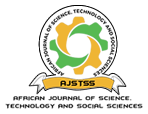Epidemiology and characterization of echinococcus in Samburu and Maasai Mara game park and surrounding environments in Kenya
DOI:
https://doi.org/10.58506/ajstss.v1i1.84Keywords:
Echinococcus sp, Taenia sp, zoonoses, hydatid diseaseAbstract
Echinococcus granulosus parasite exists in two distinct life cycle patterns; domestic cycle involving domestic dogs and livestock; and sylvatic cycle that involves wild canids and wild herbivores. The disease caused by this parasite is debilitating especially in human and it causes major economic loses to the countries affected. This study was carried out to characterize genotypes of Echinococcus species and the disease epidemiology in wildlife and domestic cycles. The study was conducted in Samburu and Maasai Mara game parks and areas close to the reserves. Humans in two pastoral communities, living in study areas were examined for presence of hydatid cysts. Additionally, animal organs were collected for inspection of hydatid cysts. Faecal samples were also collected for taeniid eggs examination, and those specimens used for genotypic analysis. A total of 4078 individuals were examined by ultrasound for presence of hydatid cysts. The prevalence of cystic echinococcosis (CE) was 1.2 % within Maasai Mara and 1.1% in Samburu. In addition, a total of 1977 organs were collected from slaughter houses and inspected for hydatid cysts, with 246 (12.4%) percent prevalence. recorded Different animals had varied frequencies of cyst burden with majority of the cysts found in liver and lungs. Nine hundred and six faecal samples of domestic dogs were screened and a taenia prevalence of 6.1% recorded. In wild life, 729 faecal samples of wild carnivores were also collected and screened for taeniid eggs with a positivity of 7.3 %. In Livestock, specific genotypes in Samburu were Echinococcosis granulosus (G1-3) the sheep strain, Echinococcus canadensis (G6/7) the Camel strain and Echinococcus ortleppi (G5) the cattle strain. Interestingly, In Maasai Mara livestock, all samples screened typed for Echinococcosis granulosus (G1-3), the most pathogenic genotype reported globally. In Samburu, genotypes in domestic dogs were E. granulosus (G1-3) (sheep strain), E. felidis (lion strain) with other Taenia species including T. multiceps, T. hydatigena, T. madoquae. For a few Taenia speciation was not possible. In Maasai Mara domestic dog samples, E. granulosus (G1-3), E. felidis, E. ortleppi, E. canadensis, T. hydatigena and T. multiceps were founds. In wild carnivores, specific genotypes including E. granulosus (G1-3) the sheep strain, E. felidis the lion strain, E. canadensis G6/7, T. hyadtigena, T. Multiceps, and T. Saginata, and Maasai Mara E. granulosus (G1-3) (the sheep strain), E. felidis, T. multiceps, and T. hyadtigena were identified. Overall, these results indicate possible interlink between domestic and wildlife Echinococcus cycles and active transmission of Echinococcus and other Taenia species. Finally, more studies on genomic differences between Echinococcus granulosus s.s genotype and Echinococcus felidis are required.


